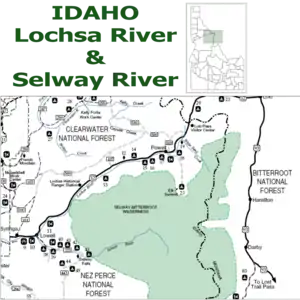Selway River
The Selway River is a large tributary of the Middle Fork of the Clearwater River in the U.S. state of Idaho. It flows within the Selway-Bitterroot Wilderness, the Bitterroot National Forest, and the Nez Perce National Forest of North Central Idaho.[5] The entire length of the Selway was included by the United States Congress in 1968 as part of the National Wild and Scenic Rivers Act.[6]
| Selway River | |
|---|---|
 Selway River at the Goat Creek rapid | |
 Course of the river | |
 Location of the mouth of the Selway River in Idaho  Selway River (the United States) | |
| Location | |
| Country | United States |
| State | Idaho |
| County | Idaho |
| Physical characteristics | |
| Source | Southeast of Stripe Mountain |
| • location | Bitterroot National Forest, Selway-Bitterroot Wilderness, Bitterroot Mountains |
| • coordinates | 45°29′49″N 114°44′37″W[1] |
| • elevation | 6,857 ft (2,090 m)[2] |
| Mouth | Meets Lochsa River to form Middle Fork Clearwater River |
• location | Lowell, Nez Perce National Forest |
• coordinates | 46°08′25″N 115°35′58″W[1] |
• elevation | 1,453 ft (443 m)[1] |
| Length | 100 mi (160 km)[3] |
| Basin size | 2,013 sq mi (5,210 km2)[4] |
| Discharge | |
| • location | Lowell, Idaho |
| • average | 3,773 cuft/s |
| • minimum | 580 cuft/s |
| • maximum | 29 573 cuft/s |
| Type | Wild, Recreational |
| Designated | October 2, 1968 |
| Reference no. | P.L. 90-542 |
The main stem of the Selway is 100 miles (160 km) in length[3] from the headwaters in the Bitterroots to the confluence with the Lochsa near Lowell to form the Middle Fork of the Clearwater. The Selway River drains a 2,013-square-mile (5,210 km2) basin in Idaho County.[4]
History
The Selway River is home to Chinook salmon. Four salmon channels were built "in the mid-1960s by the Idaho Department of Fish and Game and by the Job Corps ... along the Selway to help re-establish the spring chinook run after hydroelectric dams were built downstream." The river was stocked with salmon eggs and fry "each fall through 1981, and again in 1985."[7] A 1993 book about the project, Indian Creek Chronicles, won the Pacific Northwest Booksellers Association Book Award.[8][9]
Flora
- Cedar - Western red cedar
- ferns
- Firs – Douglas and grand fir
- Huckleberries
- Pine - ponderosa pine
- Spruce - Engelmann spruce
Wildlife
.jpg.webp)
- Birds
- Fish
- Mammals
Recreation
- Backcountry skiing
- Camping
- Fly fishing – Limits and catch-and-release
- Hiking
- Whitewater rafting – permits required
- Hunting
See also
References
- "Selway River". Geographic Names Information System. United States Geological Survey. June 21, 1979. Retrieved January 25, 2013.
- Source elevation derived from Google Earth search using GNIS source coordinates.
- U.S. Geological Survey. "The National Map: National Hydrography Dataset High-Resolution Flowline Data". Retrieved May 3, 2011.
- Bugosh, Nicholas (2000). "Lower Selway River Subbasin Assessment" (PDF). Lewiston, Idaho: Lewiston Regional Office, Idaho Division of Environmental Quality. Archived from the original (PDF) on September 18, 2015. Retrieved January 26, 2013.
- Idaho Atlas & Gazetteer (6th ed.). Yarmouth, Maine: DeLorme. 2007. pp. 52–53, 55–56. ISBN 978-0-89933-284-0.
- "Clearwater River (Middle Fork), Idaho". National Wild and Scenic Rivers System. Retrieved January 26, 2013.
- Briggeman, Kim (2011-06-12). "Students immersed in Magruder Corridor". Missoulian. Retrieved 2013-12-01.
- Fromm, Pete (2003). Indian Creek chronicles. New York: Picador. ISBN 0312422725.
- "Indian Creek Chronicles: A Winter Alone in the Wilderness by Pete Fromm". Barnes & Noble. Retrieved 2013-12-01.
Bibliography
- Floating the Wild Selway. (1991) [Missoula, Mont.?] : U.S. Dept. of Agriculture, Forest Service, Northern Region.
- Selway River Corridor: A Guide to Recreation on the Moose Creek Ranger District. (2000) Kooskia, Idaho : U.S. Dept. of Agriculture, Forest Service, Nez Perce National Forest, Moose Creek Ranger Station.
- Selway River fisheries investigations : job completion report. (1979) [Idaho] : Idaho Dept. of Fish & Game.
- A survey and evaluation of archaeological resources in the Magruder Corridor, Bitterroot National Forest, east-central Idaho, 1969. (1969) Pocatello, Idaho : Idaho State University Museum.